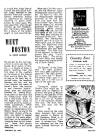
Home Page Meet Boston Menu Index
|
MEET BOSTON Friday, January 23, 1942 in What's New In Town W. J. Sidis |
It is said that Judge Samuel Sewall, the only actual Puritan Judge involved in the Danvers witchcraft condemnations, afterwards showed his repentance by wearing mourning in public every Sunday for many years. The story goes that, when he got married, up near Newburyport, the bride’s father gave him a dowry of the bride’s weight in pine-tree-shillings. He also got, by this marriage, a farm in what was then the Muddy River section of Boston―a couple of miles in extent, reaching from the hills down to the mudflats on the shores of the Charles River and the Back Bay. For as long as the Back Bay remained water, the headland between the bay and the river retained the name of Sewall’s Point (the location is now Kenmore Square). Sewall drew the distinction between his “swamp-lying” lands down by the water and his “brook-lying” lands (he had a little brook there) on the higher level, where he lived and which he could cultivate successfully. When Muddy River, in 1705, acquired its independence from Boston, Sewall, as one of the prominent citizens of the region, was asked to suggest a name for the newly-organized town; so he proposed to name the town for his ‘brook-lying’” lands. And accordingly the town is still called Brookline.
*
When the Civil War started, the first Northern troops to head south came from Boston. On April 18, 1861, the 6th Massachusetts regiment entrained at the old Fall River Line boat from Fall River to New York, then the ferry to Jersey City, and the Baltimore & Ohio train to Baltimore. While crossing Baltimore, they ran into the first battle of the Civil War when they were attacked by the people of that city. Nevertheless, the metropolitan regiment got through to Washington, and, for several weeks, the Bostonians held Washington alone against Confederates who had them surrounded. The Glee Club of that regiment, on that trip, started the song “John Brown’s Body.” The old depot from which they started has become the express building of South Station.
*
“Ed Pointer” of the Globe says: “All right, quizzers; how many state capitals are seaports?” The right answer, Ed, is: Only one―Boston. Providence might pass in a pinch, but it is well out of sight of the open sea.
*
“Correction, please” as Charlie Chan might say. A reader calls our attention to an error. We gave 25 Beacon Street as the address of the State House. The right number is 23, not 25. Number 25 is the Unitarian Society, next door. The error, however, was ours, not the printer’s.
*
What would be the most likely business that would take anyone in Boston to 100 Causeway Street or to 650 Atlantic Avenue? Answer: A railroad trip. These two addresses are the two great railroad terminals of the city.